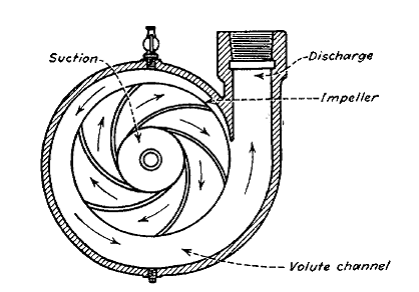Centrifugal Pump Basics
For those who may not know, centrifugal pumps are the most common type of pump, with a variety of different configurations and applications available. They work by using one or more impellers which are attached to the shaft and rotate with it. This process provides the energy to move the liquid through the pump and can even pressurize it as it moves through the system.
In more detail, the pump takes in liquid through its suction port and draws it into the inlet of the impeller. The rotation of the impeller moves the liquid along the pump while at the same time increasing its velocity energy. The liquid moves down the vanes and into either the diffuser casing or pump volute where the diffusion process converts the velocity energy of the liquid into high pressure. The liquid is then sent to the discharge port and into the system.
Centrifugal Pump Applications
According to IEEE Global Spec, the United States annually produces hundreds of thousands of centrifugal pumps which consume more than 200 billion kilowatt hours of energy each year.
Centrifugal pumps make up a great deal of these and are ideal in applications where lower viscosity and thin liquids are needed at high flow rates. They can work with clean or dirty liquids that do not contain vapors or air. For these reasons, centrifugal pumps are often used to move water and sewage in residential, industrial, and commercial applications. Common types of centrifugal pumps include:
- Chopper pumps
- End suction pumps
- Fire pumps
- Froth pumps
- Grinder pumps
- Magnetic drive pumps
Other common applications include boiler feed pumps that control the amount of water entering a boiler, dewatering pumps to remove water from a site, firefighting pumps, irrigation pumps used in agriculture, and even in solar pumps.
Along with positive displacement pumps, centrifugal can also be used as chemical pumps, circular pumps where the fluid moves through a closed system, high pressure, and other process pumps.
Number wise, centrifugal pumps have flow rate ranges between five to 200,000 gallons per minute, total head pressure from 10 to 7,500 feet, and horsepower from 0.125 all the way up to 5,000.
Pro’s and Con’s of Centrifugal Pumps
One great advantage to the centrifugal pump is that it is usually quick to install, requires less maintenance, and is easier to fix when it does need repair. The pump uses no drive seals, which eliminates the change of leakage, a costly and difficult problem. The pumps are also free of the pulsations that can be found in positive displacement pumps. Centrifugal pumps also completely separate the liquid from intake to out, meaning that none can get into the motor or other vital areas.
However, there are applications when centrifugal pumps would be disadvantageous. One of the biggest drawbacks to the centrifugal pump is its inability to provide suction power, meaning the pump must be installed below the liquid or primed before it can work. They are not recommended for working with high viscous fluid, such as those that contain ferrous particles, especially when the centrifugal pump has a magnetic drive. The pumps are also not recommended for heavy loads which can cause the coupling to slip.
Advances in Centrifugal Pumps
The simple little pump has undergone many changes, as well as offering many types of motors and applications. One of the newest ways they have been optimized is in the Grundfos PACOpaQ customized HVAC packaged system that automatically determines the optimal speed and number of pumps needed to meet desired pressure and flow. The PACOpaq utilizes heat exchangers, expansion tanks, hydraulic separators, and tangential air separators to provide a ton of benefits for the user. These include lower operating cost, longer pump life, quieter operations, reduction in maintenance, and maximum efficiency.
Centrifugal pumps are also being adopted by many developing countries in essential clean water applications. One of the most recent is the Bajo Almanzora Desalination Plant in Spain where the pumps are used to transfer sea water from tanks and into a filtration system where it is ultimately used for drinking and agriculture.
For More on Centrifugal Pumps
Below are some of our favorite resources when it comes to centrifugal pumps:
- Pump Ed 101 – A great and free mini-course on the basics of centrifugal pumps with sections on dynamics, efficiency, farce and affinity, and many others.
- Global Centrifugal Pumps Market – This extensive study by Frost & Sullivan centers on the impact of the economic recession on the centrifugal pumps market. They even provide analysis by type of pump from single-stage to multi-stage to axial- and mixed-flow, and beyond.





Thanks so much for sharing all of this information about centrifugal pumps. My son, who is an engineer, started talking about these, but I had no idea what they were, or what they are even used for! It’s really cool that this pump can be used in so many different applications and settings, and that it can even pressurize liquid! Does this mean that our homes have a lot of these pumps?
That’s an in-detail and clearly written article on centrifugal pumps! Thank you, it is very informative.
It’s a clear-cut brief article on centrifugal pumps. I appreciate you sharing. I use MTRG books and guides for reference on motors and pumps. They are good as well.
I appreciate that this article mentions that there are several benefits of using a centrifugal pump and they include a lower operating cost and maximum efficiency We have been experiencing low water pressure recently. We will potentially look into getting a new High-Pressure Centrifugal Pump.
Your blog is very informative. Here you explain centrifugal pump basics,its Applications, its Pros cons and Advances which is very useful for us. I also recommend your blog .
Thanks for Sharing
Thank you for this attractive and informative blog. This content is about centrifugal-pumps. and I am learning about Hose pump from your blog and Antlia works.
It’s really an insightful post on centrifugal pump advantages and its requirements. Keep coming up with much more posts!
Thank you for this interesting blog.
Very informative. Thanks for sharing